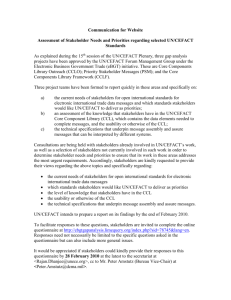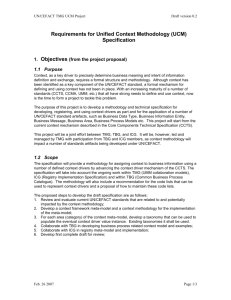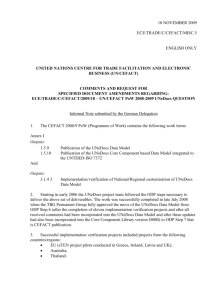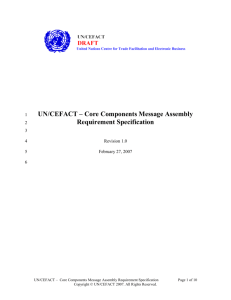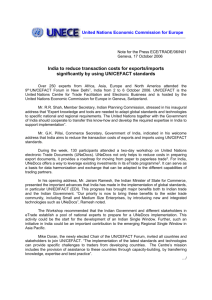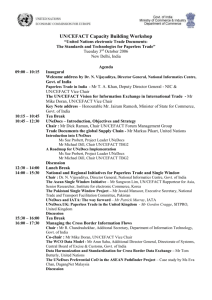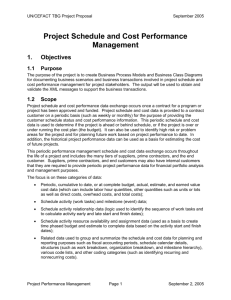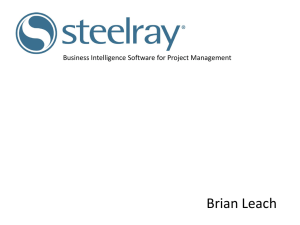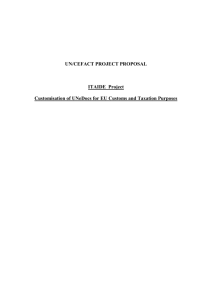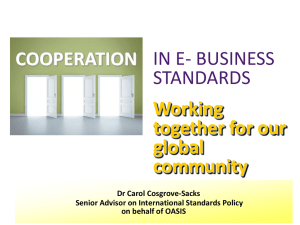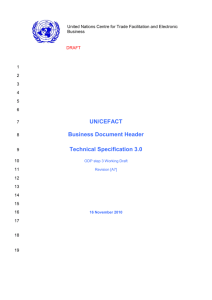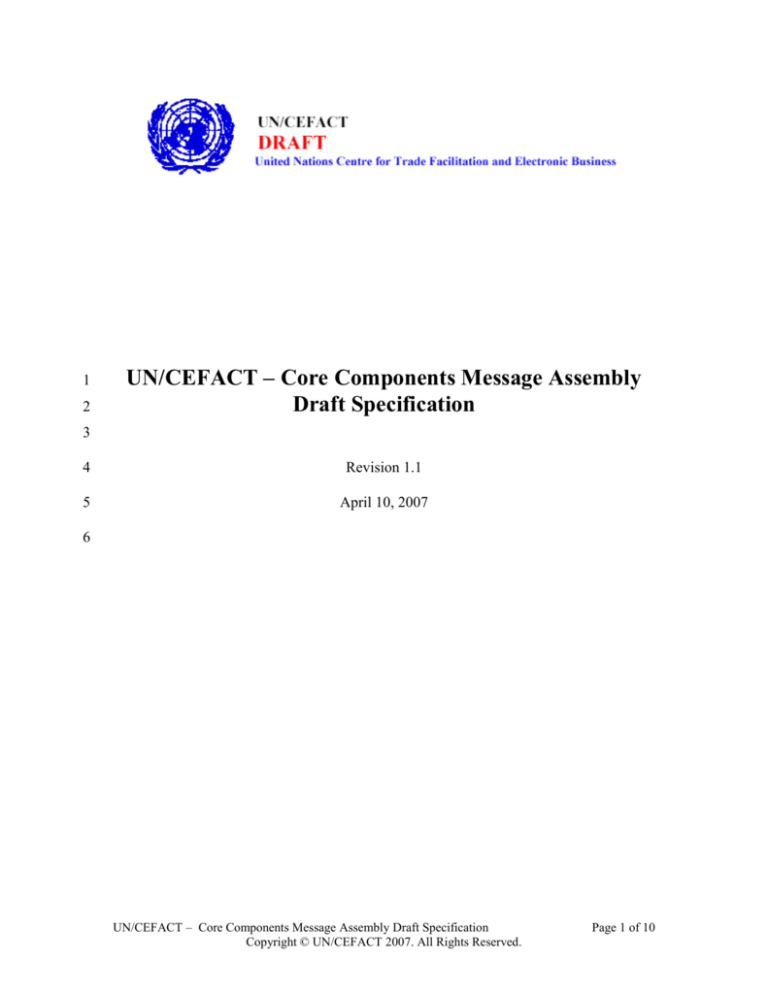
1
2
UN/CEFACT – Core Components Message Assembly
Draft Specification
3
4
Revision 1.1
5
April 10, 2007
6
UN/CEFACT – Core Components Message Assembly Draft Specification
Copyright © UN/CEFACT 2007. All Rights Reserved.
Page 1 of 10
2007-04-10
7
8
9
10
11
12
13
14
15
16
17
18
19
20
21
Table of Contents
1 Status of this Document ............................................................................................... 3
2 UN/CEFACT - CCMA Project Team Participants ...................................................... 4
2.1 Disclaimer ............................................................................................................. 4
2.2 Contact Information .............................................................................................. 5
3 Goals ............................................................................................................................ 6
4 Requirements ............................................................................................................... 6
4.1 Intro ....................................................................................................................... 6
4.2 Methodology ......................................................................................................... 6
4.3 Correlation with other UN/CEFACT specifications ............................................. 7
4.4 Message assembly details ..................................................................................... 8
4.5 Message customization ......................................................................................... 9
5 Normative References:................................................................................................. 9
Copyright Statement ..................................................................................................... 10
22
UN/CEFACT – Core Components Message Assembly Draft Specification
Copyright © UN/CEFACT 2007. All Rights Reserved.
Page 2 of 10
2007-04-10
23
1 Status of this Document
24
25
This Technical Specification is being developed in accordance with the
UN/CEFACT/TRADE/22 Open Development Process for Technical Specifications.
26
27
This document is an internal draft for review and approval by the Core Components
Message Assembly Project Team.
28
29
This document contains information to guide in the development of the technical
specification
30
31
This version: Core Components Message Assembly Draft Specification, Version 1.1 of
April 10, 2007.
32
UN/CEFACT – Core Components Message Assembly Draft Specification
Copyright © UN/CEFACT 2007. All Rights Reserved.
Page 3 of 10
2007-04-10
33
2 UN/CEFACT - CCMA Project Team Participants
34
35
We would like to recognize the following for their significant participation to the
development of this document.
36
Project Team Leader:
Gait Boxman, TIE Netherlands BV, NL
37
Lead Editor:
Serm Kulvatunyou, NIST, USA
38
39
40
41
Editing Team Members: Fred Van Blommestein, Flowcanto, NL
Mary Kay Blantz, AIAG, USA
Gunther Stuhec, SAP AG, DE
Joerg Walther, GEFEG mbH, DE
42
43
44
45
46
47
48
49
50
51
52
53
54
55
56
57
58
59
60
61
62
63
64
65
66
67
68
69
70
71
Contributors:
72
2.1 Disclaimer
Alain Chapdaniel, Actimum
Andy Schoka
Debra Cimbala, Remington, US
Duane Nickull, Adobe, CN
Freddy De Vos, Eurofer, BE
Francis Berthomieu, France Telecom, FR
Frank Vandamme, Swift, BE
Garret Minakawa, Oracle Corp, USA
Gilles Brandel, FR
Hisanao Sugamata, AFACT, JP
Hussam El-Leithy, Rosettanet, US
Ivan Bendini, France Telecom, FR
James Whittle, APACS, UK
Jean-Luc Champion, FR
Jef Barrett
Kris Ketels, Swift, BE
Kumar Sivaraman, Seebeyond, USA
Mark Crawford, LMI, USA
Molly Anderson, Eaton, USA
Margaret Pemberton, Diskray Pty Ltd, AU
Michael Dill, GEFEG, DE
Michael Onder
Michael Rowell, OAGi, USA
Nenad Ivezic, NIST, USA
Olli-Pekka Pauna, Edimaster, FI
Steve Rudelic, AIAG, USA
Steve Capell, Redwahoo, AU
Stig Korsgaard, Finansraatdet, DK
Sue Probert, UK
Sylvia Webb, GEFEG, USA
UN/CEFACT – Core Components Message Assembly Draft Specification
Copyright © UN/CEFACT 2007. All Rights Reserved.
Page 4 of 10
2007-04-10
73
74
75
76
The views and specification expressed in this document are those of the authors and are
not necessarily those of their employers. The authors and their employers specifically
disclaim responsibility for any problems arising from correct or incorrect implementation
or use of this specification.
77
2.2 Contact Information
78
TMG Chair:
Gunther Stuhec, SAP AG, de, gunther.stuhec@sap.com
79
UN/CEFACT – Core Components Message Assembly Draft Specification
Copyright © UN/CEFACT 2007. All Rights Reserved.
Page 5 of 10
2007-04-10
80
81
82
83
84
85
3 Goals
To specify the methodology to develop syntax independent business messages
from Core Components artifacts in accordance with the UN/CEFACT Modeling
Methodology (UMM).
To define a structure (meta-model) of syntax independent business messages in
accordance with the UMM.
86
4 Requirements
87
88
This section lists the requirements for the CCMA specification, organized into
prospective document sections.
89
4.1 Intro
90
91
92
93
1. Describe the need for CCMA. In other words, define how CCMA compliant business
messages connect/interact/depend with other e-business/ebXML standards including
Core Component Technical Specification (CCTS), ebXML Business Process (ebBP),
UMM compliant artifacts, and other UN/CEFACT e-business standards;
94
4.2 Methodology
95
96
97
1. Identify a methodology for message assembly;
2. Identify an environment where message assembly takes place;
a. As per UMM: add envelope to ABIE and hook up with SBDH.
UN/CEFACT – Core Components Message Assembly Draft Specification
Copyright © UN/CEFACT 2007. All Rights Reserved.
Page 6 of 10
2007-04-10
98
99
100
101
102
103
104
105
106
107
108
109
110
111
112
3.
4.
5.
6.
b.
c. Any further detail follows BIE composition methodology. (CCTS)
d. Name of Envelope in picture above: ABIE name + Transaction Pattern name,
TP name comes from BRS.
Identify what are new concepts, and which concepts we reuse from other specs;
a. No new concepts, reusing ABIE, SBDH and Information Entity.
Define what exactly is a syntax neutral business message;
Identify how CCMA business message is different from or the same as an Aggregate
Business Information Entity (ABIE) and whether an Aggregate Core Component
needs to be defined for a business message;
a. No difference
Identify whether a message structure defined by the CCMA methodology has
properties of its own;
a. Not beyond existing info in SBDH
4.3 Correlation with other UN/CEFACT specifications
UN/CEFACT – Core Components Message Assembly Draft Specification
Copyright © UN/CEFACT 2007. All Rights Reserved.
Page 7 of 10
2007-04-10
113
114
115
116
117
118
119
120
121
122
123
124
125
126
127
128
129
130
1. Identify how CCMA is associated with UMM especially the business transaction
patterns (e.g., how do we handle quality of services provided in UMM, how do we
integrate action, intention, and transaction);
a. See picture from UMM above, CCMA is a construct of exactly two ABIEs: an
SBDH and a random ABIE serving as the root of the content. The message
adopts it’s name from the content root and the UMM transaction pattern.
2. Determine the relationship between the CCMA and Unified Context Methodology
(UCM);
a. None specific, ABIEs are assumed to be built with UCM, CCMA merely
takes the resulting ABIEs.
3. Identify the role of the Standard Business Document Header (SBDH) and how to
integrate it into the message;
a. SBDH is one ABIE of the message, next to the content ABIE. All message
attributes are in SBDH.
4. Identify naming rules so we can store results in Registry and Repository (i.e., what
will be the Dictionary Entry Name (DEN));
a. ABIEs: as per CCTS, message: content ABIE DEN + transaction pattern
name from UMM.
131
4.4 Message assembly details
132
133
134
135
136
137
138
139
140
141
142
143
144
145
146
147
148
149
150
151
152
153
154
155
156
1. Identify any CCMA level requirements that are necessary to use business messages
with a messaging specification such as SOAP or ebXML messaging;
a. None beyond SBDH, note that SBDH may not be present as such in any
syntax implementation, it’s use is primarily conceptual, the content may be
spread in various constructs for a given implementation.
2. How to ensure consistency of data structure of a business message across usages and
versions;
a. Per CCTS, CCMA merely adds an SBDH to an ABIE
3. Define how context relates;
a. Through ABIE construction, nothing specific to CCMA
4. How to indicate data via references (such as the key/keyref concept);
a. Per CCTS
5. Identify how results are to be named (e.g., alignment with the UN/CEFACT Naming
and Design Rules);
a. See above
6. Develop message assembly templates and a common message assembly structure;
a. See picture above, one box for message, one for SBDH, one for content ABIE
7. Provide usage guidance/examples that derive syntax specific business messages from
syntax neutral business message;
a. TBD, but following CCTS->syntax rules mostly. Extending to message as if it
were an ABIE itself as much as possible. For EDIFACT, message and SBDH
map to service segments mostly.
8. Define handling of specific actions (verb) as to how they apply to business message
in business process transaction (e.g., how to handle empty element);
a. For CCTS
UN/CEFACT – Core Components Message Assembly Draft Specification
Copyright © UN/CEFACT 2007. All Rights Reserved.
Page 8 of 10
2007-04-10
157
158
159
160
161
162
163
164
165
166
167
168
9. Define how to use list container (gathering of repetitive information into a container
for processing these information more effectively) in the business message assembly;
a. For CCTS
10. Define a procedure for submitting complete lists or partial lists in a list container, for
e.g. updated list of a telephone book can be sent completely, or only the updated line
items will be resent;
a. For CCTS
11. Define how to use default container (the main purpose is to shrink down the volume
of the message by indicating some default values in the message, e.g., currency code)
in the business message assembly;
a. N/A, CCMA is never sent on the wire or stored as such, it’s a conceptual
model, so no compression required.
169
4.5 Message customization
170
171
172
173
174
1. How to customize message, if allowed, at the CCMA level;
a. Not allowed, use CCTS
2. Determine which aspects of customized message falls into CCMA level or syntax
specific level;
a. Not allowed
175
5 Normative References:
176
177
178
179
180
181
182
183
Core Components Technical Specification (ebCC, a.k.a. CCTS) version 2.01
UN/CEFACT Modelling Methodology, UMM (N090)
UN/CEFACT Standard Business Document Header Technical Specification
Version 1.3
ISO 11179-5 Information Technology - Metadata registries: Naming and
Identification Principles for Data Elements
UN/CEFACT XML Naming and Design Rule Specification
ebXML Business Process Specification
184
UN/CEFACT – Core Components Message Assembly Draft Specification
Copyright © UN/CEFACT 2007. All Rights Reserved.
Page 9 of 10
2007-04-10
185
Copyright Statement
186
Copyright © UN/CEFACT 2007. All Rights Reserved.
187
188
189
190
191
192
193
This document and translations of it may be copied and furnished to others, and
derivative works that comment on or otherwise explain it or assist in its implementation
may be prepared, copied, published and distributed, in whole or in part, without
restriction of any kind, provided that the above copyright notice and this paragraph are
included on all such copies and derivative works. However, this document itself may not
be modified in any way, such as by removing the copyright notice or references to
UN/CEFACT except as required to translate it into languages other than English.
194
195
The limited permissions granted above are perpetual and will not be revoked by
UN/CEFACT or its successors or assigns.
196
197
198
199
200
201
This document and the information contained herein is provided on an "AS IS" basis and
UN/CEFACT DISCLAIMS ALL WARRANTIES, EXPRESS OR IMPLIED,
INCLUDING BUT NOT LIMITED TO ANY WARRANTY THAT THE USE OF THE
INFORMATION HEREIN WILL NOT INFRINGE ANY RIGHTS OR ANY IMPLIED
WARRANTIES OF MERCHANTABILITY OR FITNESS FOR A PARTICULAR
PURPOSE.
UN/CEFACT – Core Components Message Assembly Draft Specification
Copyright © UN/CEFACT 2007. All Rights Reserved.
Page 10 of 10

